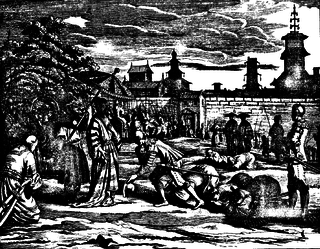
The Kingdom of Kandy was an independent monarchy of the island of Sri Lanka, located in the central and eastern portion of the island. It was founded in the late 15th century and endured until the early 19th century.

Rajasinghe I was a king of the Kingdom of Sitawaka. He is known for his extreme bravery and patriotism. Born as Tikiri Bandara to King Mayadunne of the Kingdom of Sitawaka, the name "Rajasinha" was given to him after a fierce battle against Portuguese forces. Rajasinha means the King of Lions.

Puviraja Pandaram ruled the Jaffna kingdom during a period of chaos during and after the death of his father Cankili I in 1565. He became king in 1561 following a local uprising against Cankili I. Although he was the nominal king, Cankili I wielded real power behind the throne until his death in 1565. After Cankili's death, Puviraja Pandaram lost power to one Kasi Nainar and Periyapillai. After the death or abdication of Periyapillai in 1582, Puviraja Pandarm was nominated as the king for the second time.

The Kingdom of Sitawaka was a kingdom located in south-central Sri Lanka. It emerged from the division of the Kingdom of Kotte following the Spoiling of Vijayabahu in 1521, and over the course of the next seventy years came to dominate much of the island. Sitawaka also offered fierce resistance to the Portuguese, who had arrived on the island in 1505. Despite its military successes, Sitawaka remained unstable, having to contend with repeated uprisings in its restive Kandyan territories, as well as a wide-ranging and often devastating conflict with the Portuguese. Sitawaka disintegrated soon after the death of its last king Rajasimha I in 1593.
Senarat Adahasin was king of the Kingdom of Kandy from 1604 to 1635. He is said to be the successor to king Vimaladharmasuriya I of Kandy. However first hand accounts are not available concerning what happened after the death of Vimaladharmasuriya I. He is said to be a cousin or brother of Vimaladharmasuriya according to most sources. He was not a legitimate ruler hence he married not only the deceased king’s widow Dona Catherina but also her two daughters, in order to legitimize his claim to the throne.

Mayadunne (1501–1581) was a king of the Kingdom of Sitawaka, who ruled for 60 years between 1521 and 1581. Mayadunne was a fierce opponent of the Portuguese, who had arrived on the Island in 1505. He devoted his whole life attempting to oust his brother Bhuvanekabahu, the king of Kotte and thereby preserve the independence of Lanka, which was being undermined by the Portuguese intrigue. He constantly invaded the territory of Bhuvanekabahu of Kotte.
Yamasinghe Bandara was a nephew of Karaliyadde Bandara. He helped the Portuguese take control of Kandy.
Sēnasammata Vikramabāhu was King of Kandy from 1469 to 1511. Before becoming independent the provinces that made up the Kingdom of Kandy belonged to the Kingdom of Kotte. Vikramabāhu founded the city of Kandy, and during the reign of Parakramabahu VI Kandy became a separate entity seceding from Kotte. He was from the House of Siri Sanga Bo and reigned for 4 decades, setting an example of longevity and stability for the new kingdom. His son Jayavira Bandara was his successor.
Jayavīra Banḍāra was King of Kandy from 1511 to 1552. He succeeded his father Senasammata Vikramabahu as king and was succeeded by his son Karalliyadde Bandara. During the reign of Banḍāra Catholic friars appeared at court and some conversions took place in the kingdom.
Karalliyadde Banḍāra was King of Kandy, who ruled from 1552 to 1582. During his reign Banḍāra publicly embraced Catholicism, brought to the island by the Portuguese. He and his infant daughter princess Kusumāsana Devi fled the kingdom with his retinue. The princess was later baptized by the Portuguese and called Dona Catarina. He succeeded his father Jayavira Bandara as king and was succeeded by his daughter Kusumasana Devi.
Vijayabahu VII was the son of Vira Parakrama Bahu VIII, who was an adopted child of Parakrama Bahu VI who founded Kotte. He was born in c. 1445 and grew up with his brothers Sri Rajasinghe, Dharma Parakramabahu IX, and Raigam Bandara. He also had a sister who was married to Manamperi Arachchi.
The Kandyan naval raid was a series of commerce raidings by the Kingdom of Kandy against the Portuguese empire from 16 May 1612 to 6 March 1613. With the help of Dutch envoy Marcellus de Bochouwer, King Senarat of Kandy commissioned a fleet of 3 war galleys and 3 yachts under the Admiralty of a nephew of Kuruvita Rala, the prince of Uva. They sailed from Koddiyar bay and managed to engage and inflict losses on Portuguese shipping around Ceylon and along the coast line from Cape Comorin to Calicut.

The Sinhalese–Portuguese War was a series of conflicts waged from 1527 to 1658 between the indigenous Sinhalese kingdoms of Ceylon and their allies against the Portuguese Empire. The Portuguese were seeking to expand from their trading post at Colombo to incorporate Ceylon into their growing empire.

House of Siri Sanga Bo was a powerful dynasty which ruled parts of Sri Lanka from Vijayabahu III of Dambadeniya (1220–1224) until Rajasinha I of Sitawaka (1581–1591). Vijayabahu III of Dambadeniya routed Kalinga Magha's armies from Maya Rata and established his fortress at Dambadeniya. This dynasty was able to protect their independence by facing so many foreign invasions thereafter. They had to change their capital city to Dambadeniya, Yapahuwa and Kurunagala because of continuous invasions from southern India.

The History of the Kandyan Kingdom in Sri Lanka starts with its foundation in 1476.
Kuruvita Rala was a Sri Lankan rebel leader and prince of Uva. He was also the guardian of the sons of Dona Catherina, Queen of Kandy.










